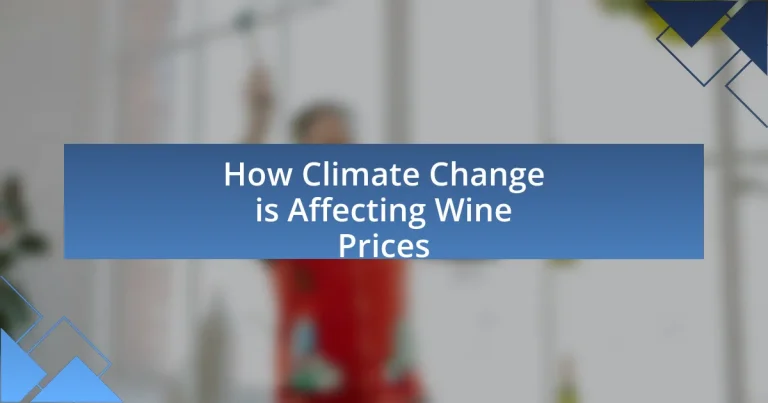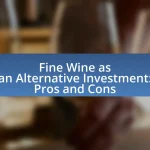Climate change is significantly impacting wine prices by reducing grape yields and altering growing conditions across traditional wine-producing regions. As temperatures rise and weather patterns become increasingly erratic, areas like Bordeaux and Napa Valley face challenges such as droughts and increased pest pressures, which threaten grape quality and quantity. This article examines the primary effects of climate change on grape production, including temperature and precipitation changes, and how these factors influence supply and demand dynamics in the wine market. Additionally, it explores the economic implications for producers, shifts in consumer behavior towards sustainability, and strategies the wine industry can adopt to mitigate these challenges.
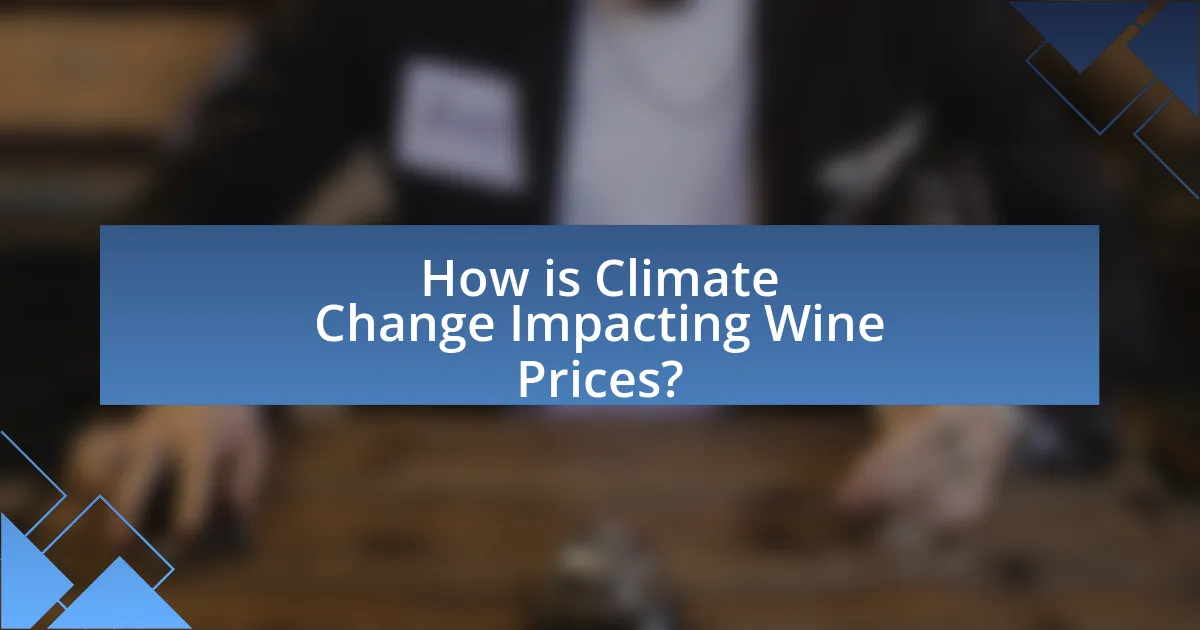
How is Climate Change Impacting Wine Prices?
Climate change is driving up wine prices due to reduced grape yields and altered growing conditions. As temperatures rise and weather patterns become more erratic, regions traditionally known for wine production, such as Bordeaux and Napa Valley, are experiencing challenges like droughts and increased pests. For instance, a study by the University of California, Davis, indicates that climate change could reduce grape yields by up to 40% in some areas by 2050. This decline in supply, coupled with consistent demand for wine, leads to higher prices in the market.
What are the primary effects of climate change on grape production?
Climate change primarily affects grape production by altering temperature, precipitation patterns, and increasing the frequency of extreme weather events. Rising temperatures can lead to earlier bud break and harvest dates, which may disrupt the timing of grape maturation and affect wine quality. Additionally, changes in precipitation can result in water stress or excess moisture, impacting vine health and yield. Extreme weather events, such as droughts and floods, can cause significant damage to vineyards, further reducing production. Studies indicate that regions traditionally known for grape cultivation may become less suitable, while new areas may emerge, shifting the global landscape of wine production.
How do temperature changes influence grape quality and yield?
Temperature changes significantly influence grape quality and yield by affecting the physiological processes of grapevines. Higher temperatures can lead to accelerated ripening, which may enhance sugar accumulation but can also reduce acidity, impacting the balance and flavor profile of the grapes. Research indicates that optimal temperature ranges for grapevine growth typically lie between 20°C and 30°C; deviations from this range can lead to suboptimal fruit development. For instance, a study published in the journal “Global Change Biology” by Jones et al. (2010) found that increased temperatures could reduce yields by up to 25% in certain regions, while also altering phenolic compounds that contribute to wine quality. Thus, temperature fluctuations directly correlate with both the quantity and quality of grape production.
What role does precipitation play in grape cultivation?
Precipitation is crucial for grape cultivation as it directly influences vine growth, fruit development, and overall yield. Adequate rainfall ensures that vines receive the necessary water for photosynthesis and nutrient uptake, which are essential for producing high-quality grapes. Studies indicate that regions with optimal precipitation levels, typically between 20 to 30 inches annually, yield better grape quality and higher wine production. Conversely, insufficient or excessive precipitation can lead to issues such as drought stress or increased disease pressure, negatively impacting grape quality and vineyard profitability.
Why are wine regions particularly vulnerable to climate change?
Wine regions are particularly vulnerable to climate change due to their reliance on specific climatic conditions for grape cultivation. Changes in temperature, precipitation patterns, and extreme weather events can directly impact grape quality and yield. For instance, studies have shown that a 1°C increase in temperature can lead to earlier grape ripening, which may affect the balance of sugars and acidity in the wine, ultimately altering its flavor profile. Additionally, regions like Bordeaux and Napa Valley are experiencing increased droughts and heatwaves, which can stress vines and reduce production. These climatic shifts not only threaten the viability of traditional grape varieties but also lead to increased costs for producers, thereby influencing wine prices.
What specific regions are most affected by climate change?
The specific regions most affected by climate change include the Mediterranean, parts of Australia, and the western United States. These areas experience increased temperatures, altered precipitation patterns, and extreme weather events, which directly impact agricultural practices, including viticulture. For instance, the Mediterranean region has seen a rise in average temperatures by approximately 1.5 degrees Celsius since the late 20th century, leading to shifts in grape growing seasons and varieties. Similarly, California’s wine regions face droughts and wildfires, which threaten grape yields and quality. These climatic changes are critical as they influence wine production and, consequently, wine prices.
How does climate change alter the terroir of wine regions?
Climate change alters the terroir of wine regions by affecting temperature, precipitation patterns, and soil composition. Increased temperatures can lead to earlier grape ripening, which may change the flavor profiles of wines produced in those regions. For instance, regions that were once ideal for certain grape varieties may become unsuitable, while others may become more favorable, shifting the traditional boundaries of wine production. Additionally, altered precipitation patterns can lead to water stress or excess moisture, impacting vine health and grape quality. Studies indicate that regions like Bordeaux are experiencing significant shifts in climate, which directly influences the terroir and, consequently, the market value of wines produced there.
How do changes in grape production affect wine prices?
Changes in grape production directly influence wine prices, as fluctuations in supply can lead to corresponding shifts in market value. When grape production decreases due to factors such as climate change, drought, or disease, the reduced supply often results in higher prices for wine, as demand remains constant or increases. For instance, the 2017 California wine grape harvest was significantly impacted by wildfires, leading to a reported 10% decrease in production, which subsequently caused wine prices to rise by an average of 5% in the following year. Conversely, an increase in grape production can lead to lower wine prices, as seen in years of abundant harvests, where oversupply can drive prices down. Thus, the relationship between grape production and wine prices is a clear reflection of supply and demand dynamics in the market.
What is the relationship between supply and demand in the wine market?
The relationship between supply and demand in the wine market is characterized by the interaction of consumer preferences and the availability of wine production. When demand for wine increases, often due to factors like changing consumer tastes or population growth, prices tend to rise if supply does not keep pace. Conversely, if supply exceeds demand, prices typically fall. For instance, in 2020, a report by the International Organisation of Vine and Wine indicated that global wine production was 260 million hectoliters, while consumption was only 244 million hectoliters, leading to a surplus that affected prices negatively. This dynamic illustrates how fluctuations in supply and demand directly influence wine pricing, particularly in the context of climate change, which can impact grape yields and thus alter supply levels.
How do vintage variations impact pricing strategies?
Vintage variations significantly impact pricing strategies in the wine industry by influencing perceived quality and scarcity. Wines from exceptional vintages often command higher prices due to their limited availability and superior characteristics, which are frequently highlighted in market analyses. For instance, a study by the University of California, Davis, found that wines from top vintages can sell for up to 300% more than those from average years, demonstrating the direct correlation between vintage quality and pricing. Additionally, wineries adjust their pricing strategies based on vintage performance, often increasing prices for wines from highly rated years to reflect their desirability and market demand.
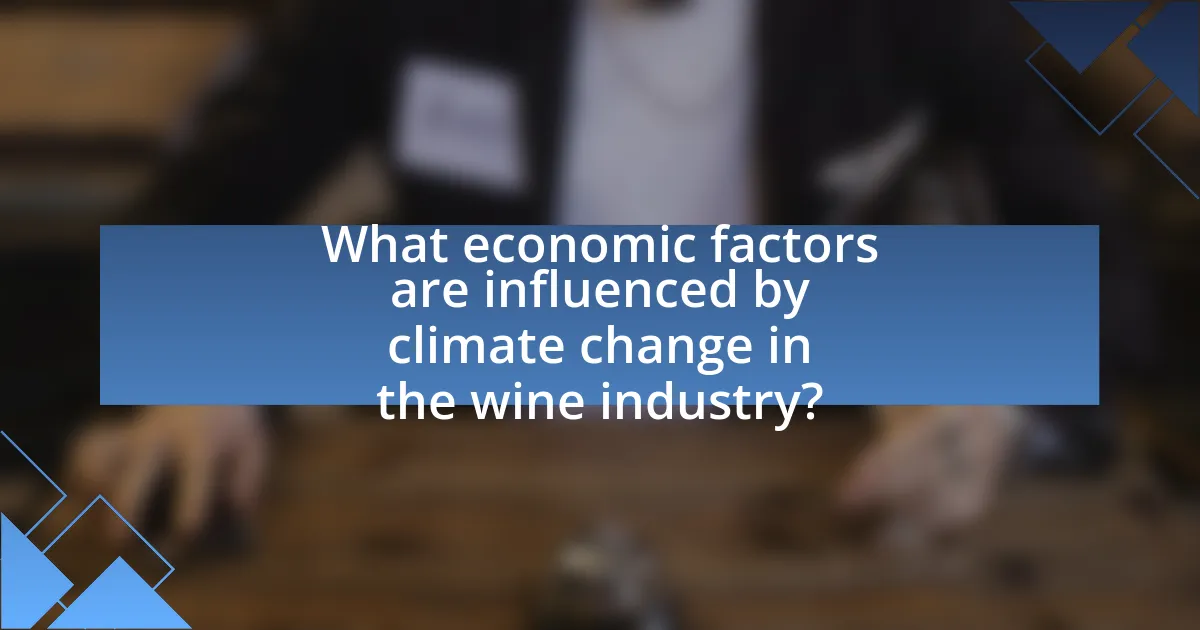
What economic factors are influenced by climate change in the wine industry?
Climate change influences several economic factors in the wine industry, including grape yield, production costs, and market prices. As temperatures rise and weather patterns shift, grapevines may produce lower yields due to heat stress and altered growing seasons. For instance, a study by the University of California found that certain wine regions could see a reduction in grape yields by up to 50% by 2050 if current climate trends continue. Additionally, increased costs for irrigation and pest management due to changing climates can elevate production expenses. These factors collectively contribute to fluctuations in wine prices, as reduced supply and higher costs often lead to increased retail prices for consumers.
How do production costs change due to climate-related factors?
Production costs in the wine industry increase due to climate-related factors such as extreme weather events, changing temperatures, and shifting precipitation patterns. These factors can lead to reduced yields, necessitating more resources for irrigation, pest control, and crop management. For instance, a study by the University of California found that rising temperatures could reduce grape yields by up to 30% in certain regions, directly impacting production costs. Additionally, increased frequency of droughts or floods can lead to higher costs for water management and soil restoration, further elevating overall production expenses.
What are the implications of increased labor costs in wine production?
Increased labor costs in wine production lead to higher overall production expenses, which can result in elevated wine prices for consumers. As labor costs rise, wineries may need to pass these expenses onto consumers to maintain profit margins, potentially making wine less accessible. Additionally, higher labor costs can incentivize wineries to invest in automation and technology to reduce reliance on manual labor, which may alter traditional production methods. According to a study by the University of California, Davis, labor costs account for approximately 30% of total production costs in the wine industry, highlighting the significant impact of labor expenses on pricing strategies.
How do changes in agricultural practices affect overall expenses?
Changes in agricultural practices significantly affect overall expenses by altering input costs, labor requirements, and yield efficiency. For instance, the adoption of precision agriculture techniques can lead to reduced fertilizer and pesticide usage, thereby lowering input costs. A study by the USDA found that precision farming can decrease input costs by up to 20%. Additionally, shifts towards sustainable practices, such as organic farming, may initially increase expenses due to certification and labor but can lead to higher market prices and consumer demand, ultimately balancing or reducing overall expenses in the long term.
What role does consumer behavior play in wine pricing amid climate change?
Consumer behavior significantly influences wine pricing amid climate change by altering demand patterns based on perceived quality and sustainability. As climate change impacts grape production, consumers increasingly prioritize wines that are marketed as environmentally friendly or produced using sustainable practices. This shift in consumer preference can lead to higher prices for wines that meet these criteria, as evidenced by a study published in the Journal of Wine Economics, which found that consumers are willing to pay a premium for wines labeled as organic or biodynamic. Additionally, the scarcity of certain wine varieties due to climate-related factors can drive prices up, as consumers may seek out limited-edition or high-quality wines, further reflecting their willingness to pay more for perceived value.
How are consumer preferences shifting in response to climate change?
Consumer preferences are increasingly shifting towards sustainable and environmentally friendly products in response to climate change. This trend is evident as consumers are more inclined to choose wines that are produced using organic farming practices, have lower carbon footprints, and utilize sustainable packaging. According to a 2021 survey by Wine Intelligence, 54% of consumers expressed a preference for wines that are certified organic or biodynamic, reflecting a growing awareness of the environmental impact of wine production. Additionally, the demand for local wines has surged, as consumers seek to reduce transportation emissions associated with imported wines. This shift in preferences is reshaping the wine market, prompting producers to adopt more sustainable practices to meet consumer expectations.
What impact does sustainability have on wine purchasing decisions?
Sustainability significantly influences wine purchasing decisions, as consumers increasingly prioritize environmentally friendly practices. A survey by Wine Intelligence in 2021 revealed that 70% of wine consumers consider sustainability when selecting a wine brand, indicating a strong preference for producers who adopt eco-friendly methods. This trend is driven by growing awareness of climate change and its effects on the wine industry, prompting buyers to support brands that demonstrate responsible sourcing, organic farming, and reduced carbon footprints. Consequently, wineries that implement sustainable practices often experience increased sales and customer loyalty, validating the impact of sustainability on consumer choices in the wine market.
How do international trade dynamics affect wine prices in a changing climate?
International trade dynamics significantly influence wine prices in a changing climate by altering supply chains, affecting production costs, and shifting consumer demand. For instance, climate change can lead to reduced yields in traditional wine-producing regions, prompting countries to import more wine, which can drive up prices due to increased demand and transportation costs. Additionally, tariffs and trade agreements can impact the cost of imported wines, further influencing market prices. According to a study published in the journal “Global Environmental Change,” climate variability has already begun to affect grape quality and harvest timing, which in turn affects pricing structures in international markets.
What are the effects of tariffs and trade agreements on wine pricing?
Tariffs and trade agreements significantly influence wine pricing by altering import costs and market accessibility. Tariffs, which are taxes imposed on imported goods, can increase the price of foreign wines, making them less competitive compared to domestic options. For instance, the 25% tariff on European wines implemented by the United States in 2019 led to higher retail prices for those wines in the U.S. market. Conversely, trade agreements can lower or eliminate tariffs, facilitating easier access to foreign wines and potentially reducing prices. The Comprehensive Economic and Trade Agreement (CETA) between Canada and the European Union, for example, aims to reduce tariffs on wine imports, which can lead to lower prices for consumers. Thus, the interplay of tariffs and trade agreements directly affects the pricing dynamics of wine in various markets.
How does climate change influence global wine markets?
Climate change significantly influences global wine markets by altering grape growing conditions, which affects wine production and pricing. Rising temperatures can lead to earlier harvests and changes in grape quality, impacting the flavor profiles and marketability of wines. For instance, regions traditionally known for specific varietals may find their climate unsuitable for those grapes, leading to a shift in production areas. According to a study published in the journal “Nature Climate Change,” regions like Bordeaux and Burgundy in France are projected to experience reduced suitability for their iconic grape varieties by 2050, potentially decreasing their wine output and increasing prices due to scarcity. Additionally, extreme weather events, such as droughts and floods, can disrupt supply chains, further influencing market dynamics and prices.
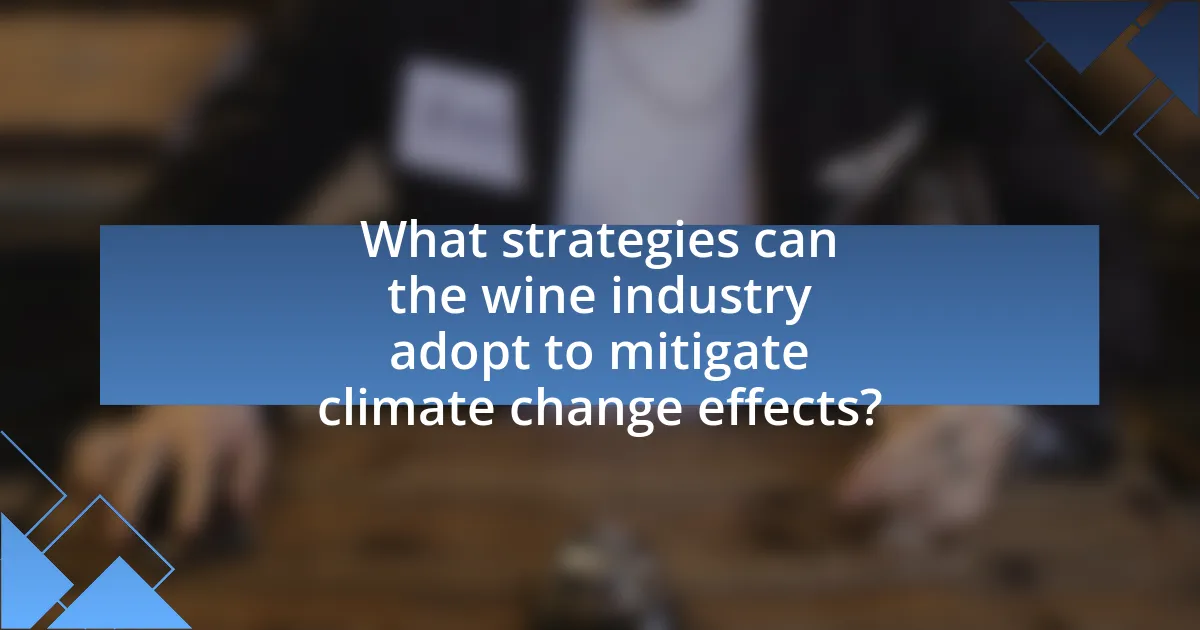
What strategies can the wine industry adopt to mitigate climate change effects?
The wine industry can adopt several strategies to mitigate climate change effects, including implementing sustainable viticulture practices, investing in climate-resilient grape varieties, and enhancing water management techniques. Sustainable viticulture practices, such as organic farming and reduced pesticide use, can improve soil health and biodiversity, which are crucial for adapting to changing climate conditions. Research indicates that adopting these practices can lead to a 20% increase in yield stability under climate stress.
Investing in climate-resilient grape varieties allows producers to select grapes that can withstand higher temperatures and altered precipitation patterns, thereby maintaining quality and yield. For instance, studies have shown that certain hybrid varieties can thrive in warmer climates, ensuring consistent production levels.
Additionally, enhancing water management techniques, such as drip irrigation and rainwater harvesting, can optimize water use efficiency, crucial in regions facing droughts. The implementation of these strategies not only helps in reducing the carbon footprint of wine production but also secures the future viability of vineyards in a changing climate.
How can wineries adapt their practices to changing climates?
Wineries can adapt their practices to changing climates by implementing strategies such as altering grape varieties, adjusting vineyard management techniques, and investing in technology for climate monitoring. For instance, selecting grape varieties that are more resilient to heat and drought can help maintain quality and yield in warmer conditions. Additionally, practices like changing planting dates, modifying irrigation methods, and employing cover crops can enhance soil health and water retention, which are crucial in fluctuating climates. Research indicates that regions like California have seen a shift towards drought-resistant varietals, which has helped sustain production levels despite increasing temperatures. These adaptive measures are essential for maintaining wine quality and economic viability in the face of climate change.
What innovative agricultural techniques are being implemented?
Innovative agricultural techniques being implemented include precision viticulture, which utilizes technology such as GPS and remote sensing to monitor vineyard conditions and optimize resource use. This approach allows for targeted interventions, improving grape quality and yield while minimizing environmental impact. Research indicates that precision viticulture can enhance water efficiency by up to 30%, crucial in adapting to climate change effects on water availability. Additionally, practices like cover cropping and integrated pest management are being adopted to enhance soil health and reduce chemical inputs, further supporting sustainable wine production in changing climates.
How can technology aid in climate adaptation for vineyards?
Technology can aid in climate adaptation for vineyards by providing advanced tools for monitoring and managing environmental conditions. Precision agriculture technologies, such as soil moisture sensors and climate modeling software, enable vineyard managers to optimize irrigation and nutrient application based on real-time data. For instance, the use of drones equipped with thermal imaging can identify areas of heat stress in vines, allowing for targeted interventions. Additionally, climate-resilient grape varieties developed through genetic research can withstand changing weather patterns, ensuring consistent yields. According to a study published in the journal “Agricultural Systems,” vineyards that adopted precision agriculture techniques saw a 20% increase in water efficiency, demonstrating the effectiveness of technology in adapting to climate challenges.
What role does consumer education play in addressing climate change in the wine sector?
Consumer education plays a crucial role in addressing climate change in the wine sector by informing consumers about sustainable practices and the environmental impact of their purchasing decisions. Educated consumers are more likely to support wineries that implement eco-friendly methods, such as organic farming and reduced carbon footprints, which can lead to a shift in industry standards. For instance, a study by the University of California found that consumer awareness of sustainability significantly influences their buying behavior, with 66% of respondents willing to pay more for sustainably produced wine. This increased demand encourages wineries to adopt practices that mitigate climate change effects, ultimately contributing to a more resilient wine sector.
How can consumers support sustainable wine practices?
Consumers can support sustainable wine practices by choosing wines from producers that prioritize environmentally friendly methods. This includes selecting organic or biodynamic wines, which are made without synthetic pesticides or fertilizers, thereby reducing chemical runoff and promoting biodiversity. Additionally, consumers can look for certifications such as Fair Trade or sustainability seals, which indicate adherence to responsible farming and labor practices. Research shows that organic vineyards can enhance soil health and reduce carbon emissions, contributing positively to climate resilience in the wine industry. By making informed purchasing decisions, consumers directly influence the market towards more sustainable practices, ultimately helping to mitigate the impacts of climate change on wine production.
What initiatives are wineries taking to promote climate awareness?
Wineries are implementing various initiatives to promote climate awareness, including adopting sustainable farming practices, reducing carbon emissions, and engaging in reforestation efforts. For instance, many wineries are transitioning to organic and biodynamic farming methods, which minimize chemical use and enhance soil health, thereby contributing to a more sustainable ecosystem. Additionally, wineries are investing in renewable energy sources, such as solar panels, to power their operations, significantly lowering their carbon footprint. Some wineries also participate in carbon offset programs, which involve planting trees to absorb CO2 emissions. These initiatives not only help mitigate climate change but also align with consumer demand for environmentally responsible products, ultimately influencing wine prices as sustainability becomes a key factor in purchasing decisions.
What practical steps can consumers take to navigate wine pricing changes?
Consumers can navigate wine pricing changes by staying informed about market trends and climate impacts on wine production. Monitoring local and global wine market reports helps consumers understand price fluctuations driven by climate change, such as reduced yields from extreme weather events. Additionally, purchasing wines from regions less affected by climate change can provide more stable pricing. Engaging with wine clubs or subscription services often offers access to better pricing and exclusive selections, mitigating the impact of price increases. Lastly, consumers can explore alternative wine varieties that may offer better value as traditional favorites become more expensive due to climate-related supply issues.
